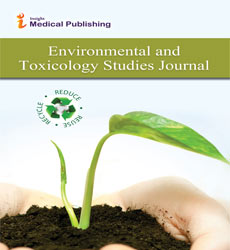Endocrine Disrupting Chemicals in the Environment: Toxicological Pathways and Human Health Consequences
Chiara Lidia*
Department of Environmental Engineering University of Barcelona, Barcelona 08028, Spain
*Corresponding author:
Chiara Lidia,
Department of Environmental Engineering University of Barcelona, Barcelona 08028, Spain,
E-mail: chiara@lidia.sp
Received date: February 01, 2025, Manuscript No. IPETSJ-25-20610; Editor assigned date: February 03, 2025, PreQC No. IPETSJ-25-20610 (PQ); Reviewed date: February 15, 2025, QC No. IPETSJ-25-20610; Revised date: February 22, 2025, Manuscript No. IPETSJ-25-20610 (R); Published date: February 28, 2025, DOI: 10.36648/.9.1.2
Citation: Lidia C (2025) Endocrine Disrupting Chemicals in the Environment: Toxicological Pathways and Human Health Consequences. Environ Toxicol J Vol.9 No.1:2
Introduction
Endocrine-Disrupting Chemicals (EDCs) are environmental contaminants capable of interfering with hormonal systems, leading to adverse health outcomes in humans and wildlife. Common EDCs include bisphenol A, phthalates, polychlorinated biphenyls, and certain pesticides, which are pervasive in industrial, agricultural, and consumer products. These compounds can mimic, block, or alter hormone signaling pathways, affecting development, reproduction, metabolism, and neurological function. Understanding the toxicological pathways of EDCs and their implications for human health is essential for risk assessment, regulatory policies, and the development of strategies to mitigate exposure [1].
Description
EDCs exert their effects primarily by interacting with nuclear and membrane-bound hormone receptors, such as estrogen, androgen, thyroid, and glucocorticoid receptors. By binding to these receptors, EDCs can either activate or inhibit normal hormonal signaling, disrupting homeostasis and leading to altered gene expression and cellular function. Some EDCs also interfere with hormone synthesis, transport, or metabolism, further amplifying their systemic impact. The complexity of these pathways, combined with low-dose and non-monotonic effects, makes predicting health outcomes challenging and underscores the need for advanced toxicological studies [2].
Chronic exposure to EDCs has been linked to a range of human health consequences. Reproductive disorders, including infertility, early puberty, and decreased sperm quality, are commonly reported outcomes. Metabolic disturbances such as obesity, insulin resistance, and type 2 diabetes have also been associated with persistent EDC exposure, likely mediated through disruption of adipogenesis and endocrine regulation of glucose metabolism [3].
Furthermore, neurodevelopmental effects, including cognitive deficits and behavioral disorders, have been observed, particularly in populations exposed during prenatal or early life stages, highlighting the vulnerability of developing systems to endocrine disruption. Beyond individual health, EDCs pose broader public health challenges due to their ubiquity and persistence in the environment. Epidemiological studies indicate that population-level exposures can exacerbate the incidence of hormone-related cancers, cardiovascular diseases, and immune dysfunction [4].
Additionally, the trans generational effects observed in some animal models suggest that EDCs may have long-lasting impacts on genetic and epigenetic regulation, potentially affecting future generations. Monitoring and regulation of EDCs, combined with public education and safer chemical alternatives, are therefore critical for mitigating their societal and health burdens. Furthermore, advances in high-throughput screening, bio monitoring, and omics-based approaches are improving the detection of subtle molecular alterations induced by EDCs, enabling earlier risk assessment and intervention they may cause genetic and epigenetic changes [5].
Conclusion
Endocrine-disrupting chemicals in the environment represent a significant toxicological and public health concern due to their ability to interfere with hormonal systems and induce diverse health effects. Understanding their molecular mechanisms, chronic exposure outcomes, and population-level impacts is essential for effective risk assessment and management. By integrating toxicological research with policy development, environmental monitoring, and public health interventions, it is possible to reduce human exposure, mitigate health risks, and safeguard vulnerable populations from the deleterious effects of EDCs.
Acknowledgement
None.
Conflict of Interest
None.
References
- Fragou D, Fragou A, Kouidou S, Njau S, Kovatsi L (2011) Epigenetic mechanisms in metal toxicity. Toxicol Mech Methods 21: 343–352
Google Scholar Cross Ref Indexed at
- Bonduriansky R, Crean AJ, Day T (2012) The implications of nongenetic inheritance for evolution in changing environments. Evol Appl 5: 192–201
Google Scholar Cross Ref Indexed at
- Shaw JL, Judy JD, Kumar A, Bertsch P, Wang MB, et al. (2017) Incorporating transgenerational epigenetic inheritance into ecological risk assessment frameworks. Environ Sci Technol 51: 9433–9445
Google Scholar Cross Ref Indexed at
- Cokus SJ, Feng S, Zhang X, Chen Z, Merriman B, et al. (2008) Shotgun bisulphite sequencing of the Arabidopsis genome reveals DNA methylation patterning. Nature 452: 215–219
Google Scholar Cross Ref Indexed at
- Jurkowski TP, Ravichandran M, Stepper P (2015) Synthetic epigenetics—towards intelligent control of epigenetic states and cell identity. Clin Epigenetics 7: 18
Open Access Journals
- Aquaculture & Veterinary Science
- Chemistry & Chemical Sciences
- Clinical Sciences
- Engineering
- General Science
- Genetics & Molecular Biology
- Health Care & Nursing
- Immunology & Microbiology
- Materials Science
- Mathematics & Physics
- Medical Sciences
- Neurology & Psychiatry
- Oncology & Cancer Science
- Pharmaceutical Sciences
